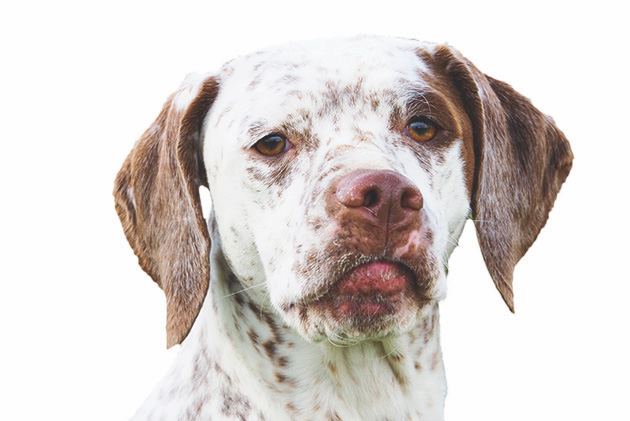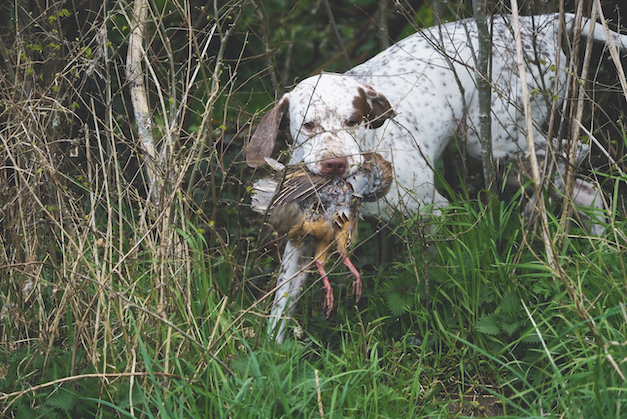Win CENS ProFlex DX5 earplugs worth £1,149 – enter here
Braque du bourbonnais – a dog with a genuine sporting pedigree
 Braque du Bourbonnais
Braque du Bourbonnais
What’s a braque du Bourbonnais? It’s a question that braque owners are frequently asked and most will tell you that it’s a type of French gundog, one of a group known in their native country as les chiens d’arrêt.
Braque du Bourbonnais – the stopping dog
The word arrêt translates as stop, indicating that these are dogs that stop when they find game. They should then point their quarry until the chasseur (hunter) arrives with his gun. France has a number of different braques, of which the best known are the Français, the Ariège, the Auvergne, the Saint-Germain and the Bourbonnais. Curiously, especially compared with their German equivalents, few have ever been imported into the UK.
Of the quintet, only the braque d’Auvergne is established here, though it remains a rare breed. In the past couple of years, it has been joined by the braque du Bourbonnais.
Earlier this month, I encountered my first-ever member of the breed, a pretty two-year-old bitch called River, owned by Tracie Rickman. If you are active in the world of working HPRs Tracie’s name is likely to be familiar, for she is the field trial secretary of the Hungarian Wirehaired Vizsla Club of Great Britain. Tracie, a professional gamekeeper, has no fewer than 12 wirehaired vizslas, so I was surprised when I heard that a French dog had joined her strictly Hungarian pack. Investigation was required.
It was, of course, a long and somewhat complicated story, but it transpired that River had been rehomed from another keeper, who didn’t have the time to make her up as a proper shooting dog. She came to Tracie as a somewhat raw 10-month-old, having received only basic training. Tracie may be an HWV enthusiast, but she also has a passion for sporting dogs and she saw in River a whole new challenge, as well as a dog that might be able to compete in continental trials.
Fortunately, River proved to have an easy-going temperament, fitting in instantly with the HWV pack. It should also be added that Tracie’s vizslas are a friendly lot and were totally unconcerned about their new French companion.
Cracking pace
What Tracie soon established was that River wasn’t only fast, but superfast. She’s a medium-sized dog, no bigger than an old-fashioned English springer, but a lighter build and longer-legged. She can cover ground at a cracking pace when hunting. A typical pointer, she air scents at a gallop, but when scent is strong her head drops slightly, indicating game.
The breed’s history
The history of the braque du Bourbonnais is an interesting one. The breed’s origins are in central France — Bourbonnais is the name of a historic province that now forms part of Allier, the northernmost department of the Auvergne. The first references to the breed date back to the 16th century and it was well established in the 19th century. The original Club du Braque du Bourbonnais formed in 1925.
The Bourbonnais was unusual in that a high percentage of dogs were born with a naturally short tail, a characteristic shared with the Brittany and a feature that suggests that the two breeds may share a common ancestry. Breeders of the Bourbonnais became more concerned about producing short-tailed dogs than working animals and, as a result, the breed declined until it was close to extinction.

Retrieving is instinctive for the braque du Bourbonnais, a popular gundog in France
Working ability
It was rescued by Michel Comte, who re-established the Club du Braque du Bourbonnais in 1982. The breed’s survival was based on a recovery programme that focused on working ability rather than appearance only. Today, this French club is both active and well supported, with an impressive and up-to-date website that is well worth a look. Dogs were first exported to the US more than 20 years ago, but the breed has not yet been recognised by the UK Kennel Club. In its native country, the Bourbonnais is regarded as a proper working dog and in the US, the dogs are mainly used for hunting. Whether the Bourbonnais is likely to catch on here as a shooting dog is debatable, as we already have so many HPR breeds to choose from, but it does have one major advantage: its size. Apart from the Brittany, all the continental HPRs are big animals.
The relatively compact dimensions of the Bourbonnais make it an attractive proposition for anyone who prefers a smaller animal. The breed standard requires dogs to weigh from 18kg to 25kg and bitches 16kg to 22kg, with heights of 51cm to 57cm and 48cm to 55cm respectively.
The Bourbonnais is a biddable breed and no more challenging to train than any of the other HPRs. Tracie reckons that the stop whistle and recall are by far the most important disciplines to instil, as the breed is so fast that it can be two fields away only seconds after slipping the lead.
Retrieving is instinctive, but, in France, more emphasis is given to the dog’s ability to hunt and point than is given to its retrieving. Though River is a silent hunter, she is vocal at home and this is also apparently a Bourbonnais trait.
There are now more than 100 Bourbonnais in the UK. I’ve no idea how many of these are worked, but I would guess a decent number, as this is a dog with a genuine sporting pedigree. If I was thinking about acquiring a pointing breed, then the Bourbonnais is certainly a dog that I would consider.
Related Articles
Get the latest news delivered direct to your door
Subscribe to Shooting Times & Country
Discover the ultimate companion for field sports enthusiasts with Shooting Times & Country Magazine, the UK’s leading weekly publication that has been at the forefront of shooting culture since 1882. Subscribers gain access to expert tips, comprehensive gear reviews, seasonal advice and a vibrant community of like-minded shooters.
Save on shop price when you subscribe with weekly issues featuring in-depth articles on gundog training, exclusive member offers and access to the digital back issue library. A Shooting Times & Country subscription is more than a magazine, don’t just read about the countryside; immerse yourself in its most authoritative and engaging publication.







